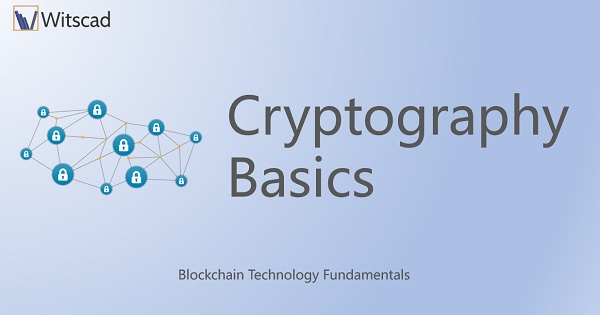A Currency is a system of money that is in practice in a country. US Dollar ($), Indian Rupee (INR), Singapore Dollar (SGD), UK Pounds, Saudi Rial are all examples of Currency. These are also referred to as Fiat Currency or Sovereign currency, as these are the legal tender form of money recognized by the respective governments and international trade. Money is used for buying and selling goods or essentials.
Digital currency is also legal money used in digital transactions and bears the properties and functions of physical currency. The advantage of digital currency is the instantaneous transfer of funds even for cross border commerce.
Digital wallet - A digital wallet or e-wallet is a replacement for our physical wallet or purse. Both wallet and e-wallet enable us to do transactions for purchase. An e-wallet can additionally hold the transaction details as a history. Like we load money in our wallet before use, an e-wallet also needs to be loaded with digital money. PayTm, AmazonPay, Google Pay, PayPal etc are examples of e-wallets. All e-wallets essentially collect our details for identity management during the registration process, after which only transactions are enabled. The history of transactions stored in the wallet and our personal information could be used by the e-wallet organizations for identifying our purchasing interest and promote new products. Identity management, Authorization, Privacy preservation and Security are some of the expected features from the e-wallet.
Cryptocurrency (CC)
Cryptocurrency is a subset of digital currencies but is not necessarily a fiat currency. While Sovereign currencies are released by the central bank of a country, Cryptocurrency is generated using cryptography techniques and has no physical form. CC is available only for digital transactions. Cryptocurrencies are generated by non-governmental groups using the process called Mining. CCs are independent of any controlling authorities. These are operated on Peer to Peer network in a decentralized functional architecture, using the trust amongst peers as a system. Cryptocurrency is difficult to be counterfeited. Anyone interested can own Cryptocurrency just like we own Fiat Currency.
Cryptocurrency has floating value, decided by user demand and circulation supply in the public market. Cryptocurrency can be used for buying goods or any other transaction within the Cryptocurrency Ecosystem. The Cryptocurrency Ecosystem has the ability to self-manage the creation of Coins, distribution of Coins and the transactions.
Properties of Cryptocurrency
Cryptocurrencies share many properties in common with Fiat Currencies as listed below:
- Fungible – Mutually interchangeable. One unit is equal to another unit of the same coin no matter when it is generated.
- Divisible – Can be used in parts of one coin. Ex. 0.01 bitcoin can be used for a transaction.
- Acceptable – As a medium of exchange.
CCs are e-currency and hence can only be traded in e-transactions. Cryptocurrencies are customizable. It eliminates Double-spend, which is a very desired feature for a healthy economy.
Mining
The process of generating valid crypto coins is called "Mining". The interested computers connected to the P2P network participate in solving the hard crypto puzzle. These computers are called “Miners” and are required to have powerful hardware and software for solving the puzzle. The one who solves the puzzle publishes the result in the network. The consensus mechanism confirms the solution to be correct and identifies it to be the earliest solution. The reward for solving the puzzle early is writing a Block in the Blockchain with ownership of X number of coins. The current reward value of X is 12.5 bitcoins in the bitcoin network. In the year 2015, the reward was 25 Bitcoins. A block is added every 10 minutes approximately to the Bitcoin network and hence coins are also added to the network.
It is to be noted that there will be more than one and many nodes trying to solve the puzzle at the same time. However, only one happens to be the winner to own the X coins. From this moment, the rest of the nodes will stop solving the puzzle. However, these nodes are incentivized for the participation to solve the puzzle, in terms of CC valuing less than X coins. The incentive will be proportional to the partial work done in solving the puzzle. Subsequently, all Miners start competing to solve the next puzzle and mine the new currency.
Now, it is easy to understand how the consensus mechanisms like Proof of Work, Proof of Stake or other such mechanisms have relevance and purpose in the Cryptocurrency network.
What is the Puzzle?
Still, there could be one question in the minds of the reader, where does it all start? i.e. the start of the puzzle?
The puzzle in the case of CC is to take the last block header and find a hash which is lower than that. When a block is written after consensus, all miners are aware of the header value of the recently created block. At this moment, the current puzzle closes, coins and incentives rewarded and the competition for the next puzzle solution starts. This ensures sync with all members and all Miners are given a fair chance to start the work at the same time.
The solution to the puzzle is about identifying a number lower than the block header. This number is called "Nonce". A Nonce is a number used only once. The number needs to be created using hashing algorithms like SHA-256, RSA, etc., as configured in the network. Figure 8.1 gives the example of hash and Nonce. Generating a Nonce is not an easy joke. The Nonce creation requires 232 attempts by the system to create a new number, which indicates the complexity of this mathematical puzzle and the requirement of ultra-powerful hardware and the algorithm. It is the powerful hardware that makes a miner a winner. ASIC based Mining Farm photos are shown in Figure 8.2. The heat generated is enormous and the electricity consumption so high that these systems are housed differently.
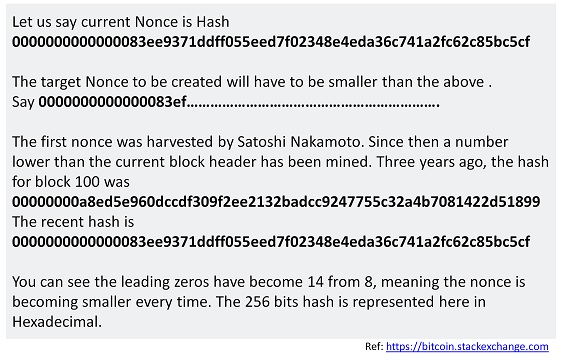

Core components of Cryptocurrency
In the making of the CC system, the functionalities required are Creation of Coins (Mining), Managing Transactions and updation of coin ownership after a transaction. These functionalities are managed by the core components namely Blockchain, Cryptography, Distributed Decentralized Nodes Network, Mining by Consensus, Transactions, Wallet and Crypto Exchange.
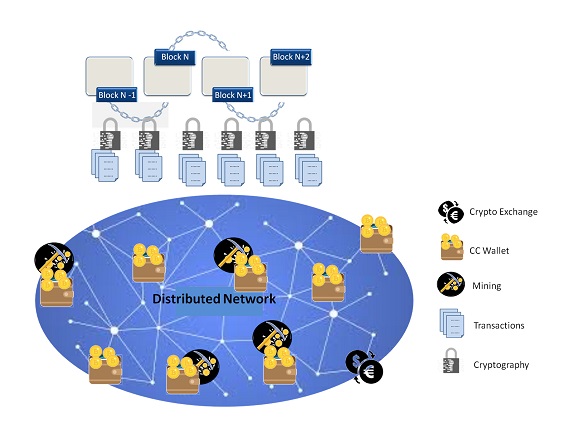
Blockchain – Blockchain is the backbone of any cryptocurrency system. All the CC transactions are recorded in the Distributed Ledger (DL). The benefits of Distributed Ledger Technology (DLT) comes along with its functionalities.
Network - Nodes are part of the Decentralized Peer to Peer Network. Any computer which installs the CC Client Software becomes a member of the network. Exit from the network is generally decided by time-bound absenteeism. i.e. if a node is not seen for some time, say more than 3 hours then it is considered to have dropped from the network. The network is random peers type; there is no fixed topology.
Mining – We have dealt in detail about mining earlier in the chapter. To summate, Miners have six things to do.
- Listen to Transactions broadcast in the network
- Maintain Blockchain in their system
- Assemble a candidate block
- Solve the hash puzzle and find Nonce to make your block valid
- Hope that the block is accepted by consensus validation
- Reap the profit of CC
CC Wallet - Our Wallet holds our physical currency. Similarly, a CC Wallet holds the CC. i.e. We can receive CC into our CC Wallet and also we can spend from our CC Wallet for transactions or merchandise. A CC Wallet has an address, which is to be mentioned while receiving CC. The Wallet holder has a Public Key and a Private Key. The Public Key is used for receiving CC, while the Private Key is used while sending out money from the CC Wallet. The wallet is held in the nodes that are connected to the CC network for enabling transactions. The received CCs are kept distinct i.e. each time a CC is received, it is considered as a transaction and the entries are reflected in the network DL. For example, if a wallet has received 3, 2, 0.1, 0.01 CC in different transactions, then, these are kept as blocks with different addresses in the wallet as in figure 8.4. This enhances the traceability of the CC.

CC Transactions – CC Transaction occurs whenever there is a transfer of CC between CC wallets for merchandise or transfer of funds. In the physical world, Cash transactions are anonymous. But CC transactions are Pseudonymous. Pseudonymity is traceable.
There are some specifics to be noted concerning CC. Two example cases of transactions are shown in figure 8.5. The coins are stored with a specific address as they are received into the wallet. While spending, these can be taken out as units of receipts only. If the proper quantum of CC is not available, a reverse transaction is endorsed to Alice's wallet, for the change to be returned (refer to Fig. 8.5). This refund change will get stored in a new address as in case B. Case A is the scenario of Alice having an exact change of CC required. The details in figure 8.5 are self-explanatory to understand the modality of transactions.
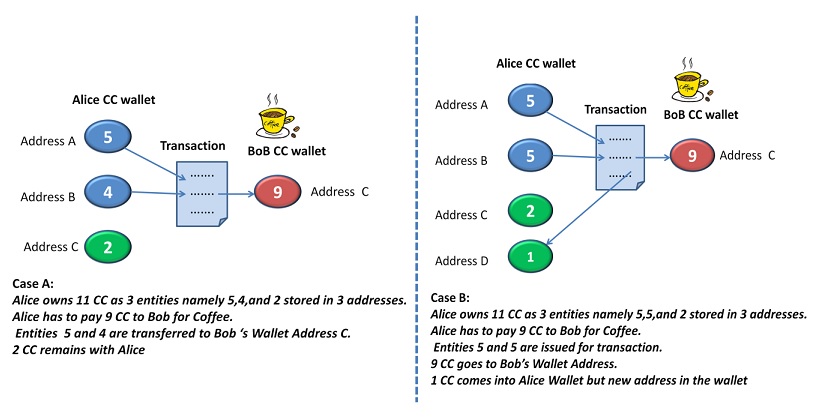
Cryptography - In CC, cryptography is useful to encode the rules of the CC system. We have discussed in length about cryptography in the earlier chapter.
CC Exchange - CC Exchange is a place in the Web, where a CC can be traded for another CC or a Fiat Currency based on its market value. The CC can also be put into open circulation via cryptocurrency exchanges. CC exchanges also perform functions similar to a bank, like accepting to hold our CC and allowing us to draw.
More about CC
Bitcoin Core is the Opensource Software with MIT Licence. MIT allows anybody to use it. Bitcoin Core is the De-facto Rule book of Bitcoin functionality. Anyone interested can find the historical value of Bitcoin, Mining time requirement, History, etc., over Google. Since Bitcoin is the most popular one, we have been referring to it in various instances. Now, there are countless crypto coins in the virtual world. The most popular ones are shown in figure 8.6.
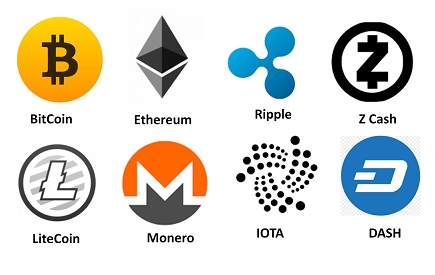
How is Cryptocurrency used?
Once CCs are acquired by the miner, these are put into circulation to the members of the network for transacting within the network. In a Fiat currency system, when money is transferred via electronic transfer, the transfer is managed through banks. In the case of CC, only the users of the network are involved. The Blockchain-based Cryptocurrency system acts as a self-regulating and self-monitoring of each of the mined coins and the transactions that are part of the network. The components of the CC Eco-system ensure this. Figure 8.7 describes the coexistence of the physical and Cryptocurrency world.

